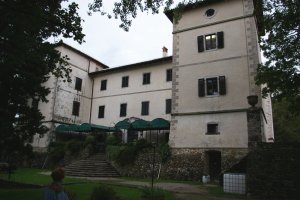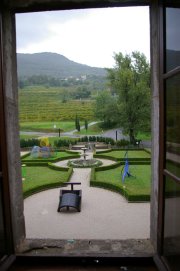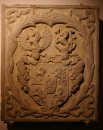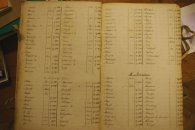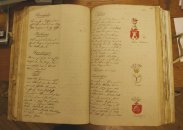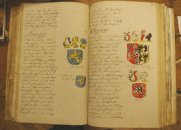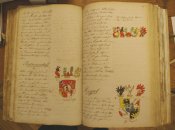|
Societas Heraldica Slovenica October 2005 Kromberk Castle and Goriško Museum Kromberk Castle and its beautifully restored Baroque park stand on the side of a hill not too distant from Nova Gorica. Built around 1600 on the site of an older medieval castle, it is unique by virtue of its four story corner towers.
The artifacts on display at Kromberk Castle focuses on art history, archaeology and ethnology of the Goriško region. From a heraldry perspective, the museum offers a collection of coats of arms crafted from large stones which grace the walls on the main floor area adjacent to the main entrance and also the walls in the stairwells leading to the upper floors. Another fascinating and little known artifact resident in the castle collection is an armorial published in 1857 - 1858 by an unknown author who's only clue are the initials "O.T.V.H.". A member of the SHS suggests that the initials may be those of Otto Titan von Hefner, a heraldic author who also published "J. Siebmacher's grosses und allgemeines Wappenbuch" in 1856, however, there is no direct evidence to support this suggestion at this time. The armorial book depicts the coats of arms and their descriptions (blazon) from the areas of Krain, Görz, Kärnten and Šteier. The sections were completed in different years: Krain - 1857, Görz - 1857, Kärnten - 1858 and Šteier - 1858. It also appears that for each section, there was a different heraldic artist and different scribes, as each section has its own unique illustration and writing styles. The arms of Šteier depict the classical "Vert, a panther Argent" which remains the arms of Styria today. The arms of Krain depicts the classic "eagle displayed Azure charged on the breast with a crescent counter compony Argent and Gules of 32" which is different than the arms as depicted by Valvasor in "Opus Insignium Armorumque" which depicts the crescent with an "enhancement" indicated by a crescent counter compony Or and Gules. See the arms of Carniola as depicted by Valvasor by clicking here. Coats of Arms in stone... Click on the images below to view a larger version of the same.
Below is a virtual tour of the main hall of Kromberk Castle which effectively presents the main display of heraldic arms stonework. The virtual tour is courtesy of Utrinki iz Slovenije by . Goriško Armorial - O.T.V.H. Click on the images below to view a larger version of the same.
It is clear that these early works relied on references of previous works. For example, the unfinished arms of Bonhomo and Brenner, are complete in Janez Vajkard Valvasor, "Opus Insignium Armorumque 1687 - 1688 Das Grosse Wappenbuch (Bonhomo 48, 57, 64, 139 and Brenner 70, 105). Färber's arms also can be found in Valvasor's armorial, with the only difference is the portcullis (the castle's gate) is "Gules" (red) in Goriško armorial and "Sable" (black) in Valvasor. Feulner's arms are incomplete in Goriško armorial and which are also depicted in Valvasor's armorial. It's field is illustrated as "Gules" (red). The arms of Glowizer appears to depict a lion rampant Or in the upper arms, and below are similar arms, except the lion is sitting or "sejant erect". In Valvasor's armorial, similar arms are illustrated, but with the lion sejant erect only. Glojach or Gloyach as it is spelled in Valvasor are similarly illustrated, except for the arms illustrated in O.T.V.H. depict marshalling, that is, the son of the Glojach family married into a family which was also armigerous (one who possesses a coat of arms). This results in the paternal arms being segmented in half, to include the arms of the wife's family. Ratmansdorff has some inconsistency between the Goriško armorial and Valvasor's. The second quarter in Goriško's armorial is illustrated with a field "Gules" whereas, the same quarter in Valvasor is illustrated with a field "Argent". The reasoning behind this inconsistency is not known. Within Goriško's armorial, Ratmansdorff is spelled with as "Ratmansdorff" and as "Rattmansdorff". An early version of a "typographical" error? It is interesting to note some of the differences between the arms illustrated in the Goriško armorial and Valvasor's armorial. This may be attributed to the differences in the dating of the arms depicted, in that the arms may reflect significant changes to the status of the family which is then reflected in enhancements to their arms. Bibliography
by David M. Cvet About the author: , born in Canada, son of Slovenian parents, is director of the Royal Heraldry Society of Canada (RHSC), president of the Toronto Branch of the RHSC, president and founder of the Academy of European Medieval Martial Arts in Toronto, and is also the founder of the Societas Heraldica Slovenica. During his study, research and reconstruction of medieval martial arts, he discovered heraldry had played a significant part in medieval history, and has expanded his research and study to include heraldry of Slovenia. SHS Copyright © 2005 All Rights Reserved Updated: October 16, 2005 | |||||||||||||||||||||||||||||||||||||||||||||||||||||||||||||
